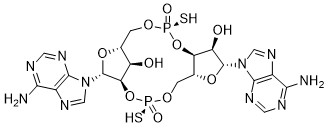| Description: |
ML-RR-S2 CDA is a potent STING-activating cyclic di-adenosine (CDA or c-diAMP) nucleotide ligand with the 2′-5′, 3′-5′ mixed phosphodiester linkage (ML) in the [Rp,Rp] configuration and doubly substituted thiophosphate (S2) for optimal phosphodiesterase-resistance and thereby enhanced cellular potency. ML-RR-S2 CDA effectively induces IRF3, NF-kB, and STAT6 transcription activities in a STING-dependent manner in both murine (DC2.4 & BMMs) and human (THP1 & PBMCs) cultures (5-100 μM) as well as displays profound anti-tumor efficacy in vivo (100% growth inhibition of established B16.F10, 4T-1 or CT26 tumor with 3X 50 μg/mouse/96 hr intratumoral injections) with lasting immune-mediated tumor rejection.It contains mixed linkages (ML) with both 2'5' and 3'5' linkages, which leads to increased thermal stability of human STING in a differential scanning fluorimetry (DSF) assay. ML RR-S2 CDA increases type I interferon production by THP-1 human monocytes relative to unmodified cyclic di-AMP, indicating the ML enhances its action at human STING. It induces expression of IFN-β and the pro-inflammatory cytokines TNF-α, IL-6, and Mcp-1 in murine bone marrow macrophages (BMM) isolated from wild-type, but not STING-/-, mice. ML RR-S2 CDA also induces IFN-β expression in peripheral blood mononuclear cells (PBMCs) isolated from donors carrying STINGWT/WT, STINGWT/REF, and STINGWT/HAQ alleles. In vivo, ML RR-S2 CDA initiates tumor regression and prevents tumor growth upon tumor cell reimplantation in 4T1 breast and CT26 colon cancer mouse xenograft models. |
| Target: |
STING[1] |
| In Vivo: |
ADU-S100 shows higher anti-tumor control than the endogenous ML cGAMP. A dose response of the ADU-S100 compound is performed in B16 tumor-bearing mice, which identifies an optimal antitumor dose level that also elicites maximum tumor antigen-specific CD8+ T cell responses, and improves long-term survival to 50%[1]. |
| In Vitro: |
ADU-S100 shows enhanced type I IFN production over CDA in THP-1 human monocytes. In contrast, the dithio, mixed-linkage cyclic dinucleotide (CDN) derivatives (ML RR-CDA, ML RR-S2 CDG, and ML RR-S2 cGAMP) potently activate all five hSTING alleles, including the refractory hSTINGREF and hSTINGQ alleles. ADU-S100 induces the highest expression of IFN-β and the pro-inflammatory cytokines TNF-α, IL-6, and MCP-1 on a molar equivalent basis, as compared to endogenous ML cGAMP and the TLR3 agonist poly I:C. ADU-S100 is also found to induce aggregation of STING and induce phosphorylation of TBK1 and IRF3 in mouse bone marrow macrophage (BMM). ADU-S100 induces significantly higher levels of IFN-α when compared to ML cGAMP[1]. |
| Cell Assay: |
Cryopreserved hPBMCs are thawed and 1×106 cells per well are plated in a 96 well plate in RPMI media supplemented with 10% FBS, 1% non-essential amino acids, 1% penicillin/streptomycin, L-glutamine, 10 mM HEPES buffer, 1 mM Sodium Pyruvate, 0.055 mM β-ME at 37°C with 5% CO2. Cells are stimulated with 10 μM ADU-S100 or ML cGAMP for 6 hours and supernatants are harvested. Supernatants are diluted 1:2 and assayed for IFN-α protein using Cytometric Bead Array (CBA) Human Flex Set. Data is collected using a FACSVerse cytometer and analyzed by FCAP Array Software[1]. |
| Animal Administration: |
Mice[1] WT C57BL/6 mice are inoculated with 5×104 B16.F10 cells in the left flank (n=8). When tumor volumes are 100 mm3 mice receive three IT doses of either ML RR-S2 CDG (25 μg), ADU-S100 (50 μg), or HBSS as control. WT C57BL/6 mice are inoculated with 5×104 B16.F10 cells in the left flank (n=5). When tumor volumes are 100 mm3 they received three IT doses of ADU-S100 at 5, 25, 50 or 100 μg or HBSS as control. WT C57BL/6 mice are inoculated with 5×104 B16.F10 cells in the left flank (n=8). When tumor volumes are 100 mm3 they receive three IT doses of 100 μg ADU-S100 or HBSS as control. Treatments are administered on days 13, 17 and 20 and tumor measurements are taken twice weekly. Results are shown as percent survival by Log-rank (Mantel-Cox) test (A and C)[1]. |
| References: |
[1]. Corrales L, et al. Direct Activation of STING in the Tumor Microenvironment Leads to Potent and Systemic Tumor Regression and Immunity. Cell Rep. 2015 May 19;11(7):1018-30. |






















